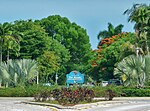Immaculata-LaSalle High School
1958 establishments in FloridaCatholic secondary schools in FloridaCoconut Grove (Miami)Educational institutions established in 1958Immaculata-LaSalle High School alumni ... and 3 more
Private high schools in Miami-Dade County, FloridaSalesian secondary schoolsSchools in Miami
Immaculata-LaSalle High School is a private, Roman Catholic high school in the Coconut Grove neighborhood of Miami, Florida. It is part of the Roman Catholic Archdiocese of Miami and located between Mercy Hospital and Vizcaya on South Bayshore Drive. The school was officially founded as Immaculata Academy, a Roman Catholic college preparatory school for girls, on September 1, 1958. The Sisters of St. Joseph Congregation of St. Augustine FL were the school's founding religious order. The school is now run by the Salesian Sisters of Don Bosco.
Excerpt from the Wikipedia article Immaculata-LaSalle High School (License: CC BY-SA 3.0, Authors).Immaculata-LaSalle High School
South Miami Avenue, Miami
Geographical coordinates (GPS) Address Nearby Places Show on map
Geographical coordinates (GPS)
| Latitude | Longitude |
|---|---|
| N 25.743333333333 ° | E -80.214444444444 ° |
Address
South Miami Avenue
33129 Miami
Florida, United States
Open on Google Maps









